Review of Recent Phased Arrays for Millimeter-Wave Wireless Communication
Abstract
:1. Introduction
1.1. Phased Array
1.2. Millimeter-Wave 5G Wireless Communication
2. Millimeter-Wave Antenna Array for 5G Communication
2.1. Millimeter-Wave Antenna Arrays for 5G Mobile Terminals
2.1.1. Multilayer Phased-Array Antennas for 5G Mobile Terminals
2.1.2. Multi-Polarized Multilayer Phased-Array Antennas for 5G Mobile Terminals
2.1.3. Single-Layer Phased-Array Antennas for 5G Mobile Terminals
2.2. Millimeter-Wave Phased Arrays for 5G Access Terminals
2.2.1. Millimeter-Wave PCB Phased Arrays
2.2.2. Millimeter-Wave RFIC Phased Arrays
3. Discussion
4. Conclusions
Author Contributions
Funding
Conflicts of Interest
References
- Parker, D.; Zimmermann, D.C. Phased arrays―Part 1: Theory and architectures. IEEE Trans. Microw. Theory Tech. 2002, 50, 678–687. [Google Scholar] [CrossRef]
- Niknejad, A.M.; Hashemi, H. Integrated Beamforming Arrays. In mm-Wave Silicon Technology; Series on Integrated Circuits and Systems; Springer Science and Business Media: Berlin, Germany, 2008; ISBN 978-0-387-76561-7. [Google Scholar]
- Carpentieri, E.; Elia, U.F.D.; Stefano, E.D.; Guida, L.D.; Vitiello, R. Millimeter-Wave Phased-Array Antennas. In Proceedings of the IEEE Radar Conference, Rome, Italy, 26–30 May 2008; pp. 1–5. [Google Scholar]
- Dahlman, E.; Mildh, G.; Parkvall, S.; Peisa, J.; Sachs, J.; Selen, Y.; Skold, J. 5G wireless access: Requirements and realization. IEEE Commun. Mag. 2014, 52, 42–47. [Google Scholar] [CrossRef]
- Marcus, M.J. 5G and “IMT for 2020 and beyond” [Spectrum Policy and Regulatory Issues]. IEEE Wirel. Commun. 2015, 22, 2–3. [Google Scholar] [CrossRef]
- Rappaport, T.S.; Sun, S.; Mayzus, R.; Zhao, H.; Azar, Y.; Wang, K.; Wong, G.N.; Schulz, J.K.; Samimi, M.; Gutierrez, F. Millimeter wave mobile communications for 5G cellular: It will work! IEEE Access 2013, 1, 335–349. [Google Scholar] [CrossRef]
- Hong, W.; Baek, K.H.; Ko, S. Millimeter-Wave 5G Antennas for Smartphones: Overview and Experimental Demonstration. IEEE Trans. Antennas Propag. 2017, 65, 6250–6261. [Google Scholar] [CrossRef]
- Pi, Z.; Khan, F. An introduction to millimeter-wave mobile broadband systems. IEEE Commun. Mag. 2011, 49, 101–107. [Google Scholar] [CrossRef]
- Zhang, J.; Ge, X.; Li, Q.; Guizani, M.; Zhang, Y. 5G Millimeter-Wave Antenna Array: Design and Challenges. IEEE Wirel. Commun. 2017, 24, 106–112. [Google Scholar] [CrossRef]
- Hong, W.; Baek, K.H.; Lee, Y.; Kim, Y.; Ko, S.T. Study and prototyping of practically large-scale mmWave antenna systems for 5G cellular devices. IEEE Commun. Mag. 2014, 52, 63–69. [Google Scholar] [CrossRef]
- Dehos, C.; González, J.; Domenico, A.; Kténas, D.; Dussopt, L. Millimeter-wave access and backhauling: The solution to the exponential data traffic increase in 5G mobile communications systems? IEEE Commun. Mag. 2014, 52, 88–95. [Google Scholar] [CrossRef]
- Dussopt, L.; Bouayadi, O.E.; Alberto, J.; Luna, Z.; Dehos, C.; Lamy, Y. Millimeter-Wave Antennas for Radio Access and Backhaul in 5G Heterogeneous Mobile Networks. In Proceedings of the 9th European Conference on Antennas and Propagation, Lisbon, Portugal, 12–17 April 2015; pp. 1–4. [Google Scholar]
- Kim, Y.; Lee, H.Y.; Hwang, P.; Patro, R.K.; Lee, J.; Roh, W.; Cheun, K. Feasibility of Mobile Cellular Communications at Millimeter Wave Frequency. IEEE J. Sel. Top. Signal. Process. 2016, 10, 589–599. [Google Scholar] [CrossRef]
- Hur, S.; Kim, T.; Love, D.J.; Krogmeier, J.V.; Thomas, T.A.; Ghosh, A. Millimeter wave beamforming for wireless backhaul and access in small cell networks. IEEE Trans. Commun. 2013, 61, 4391–4403. [Google Scholar] [CrossRef]
- Yang, B.; Yu, Z.; Lan, J.; Zhang, R.; Zhou, J.; Hong, W. Digital Beamforming-Based Massive MIMO Transceiver for 5G Millimeter-Wave Communications. IEEE Trans. Microw. Theory Tech. 2018, 1–16. [Google Scholar] [CrossRef]
- Helander, J.; Sjoberg, D.; Gustafsson, M.; Zhao, K.; Ying, Z. Characterization of millimeter wave phased array antennas in mobile terminal for 5G mobile system. In Proceedings of the IEEE International Symposium on Antennas and Propagation & USNC/URSI National Radio Science Meeting, Vancouver, BC, Canada, 7–8 October 2015; pp. 7–8. [Google Scholar]
- Rajagopal, S.; Surra, S.A.; Pi, Z.; Khan, F. Antenna array design for multi-Gbps millimeter wave mobile broadband communication. In Proceedings of the Global Telecommunications Conference (GLOBECOM 2011), Houston, TX, USA, 5–9 December 2011; pp. 1–6. [Google Scholar]
- Wang, J.J.H.; Corporation, W.E. Wideband Wide-Scan Millimeter-Wave Phased Arrays for Enhanced Security/Privacy and Performance in 5G Mobile Wireless. In Proceedings of the IEEE International Symposium on Antennas and Propagation & USNC/URSI National Radio Science Meeting, San Diego, CA, USA, 9–14 July 2017; pp. 1471–1472. [Google Scholar]
- Bas, C.U.; Wang, R.; Psychoudakis, D.; Henige, T.; Monroe, R.; Park, J.; Zhang, J.; Molisch, A.F. A real-time millimeter-wave phased array MIMO channel sounder. In Proceedings of the IEEE 86th Vehicular Technology Conference: VTC2017-Fall, Toronto, ON, Canada, 24–27 September 2017; pp. 1–6. [Google Scholar]
- Niu, Y.; Li, Y.; Jin, D.; Su, L.; Vasilakos, A.V. A survey of millimeter wave communications (mmWave) for 5G: Opportunities and challenges. Wirel. Netw. 2015, 21, 2657–2676. [Google Scholar] [CrossRef]
- Brady, J.; Hogan, J.; Sayeed, A. Multi-beam MIMO prototype for real-time multiuser communication at 28 GHz. In Proceedings of the Globecom Workshops (GC Wkshps), Washington, DC, USA, 4–8 December 2016; pp. 1–6. [Google Scholar]
- Han, S.; Chih-Lin, I.; Xu, Z.; Rowell, C. Large-scale antenna systems with hybrid analog and digital beamforming for millimeter wave 5G. IEEE Commun. Mag. 2015, 53, 186–194. [Google Scholar] [CrossRef]
- Alexandropoulos, G.C. Position Aided Beam Alignment for Millimeter Wave Backhaul Systems with Large Phased Arrays. In Proceedings of the IEEE 7th International Workshop on Computational Advances in Multi-Sensor Adaptive Processing (CAMSAP), Curacao, The Netherlands, 10–13 December 2017; pp. 1–5. [Google Scholar]
- Hong, W.; Jiang, Z.H.; Yu, C.; Zhou, J.; Chen, P.; Yu, Z.; Zhang, H.; Yang, B.; Pang, X.; Jiang, M.; et al. Multibeam Antenna Technologies for 5G Wireless Communications. IEEE Trans. Antennas Propag. 2017, 65, 6231–6249. [Google Scholar] [CrossRef]
- Björnson, E.; Van der Perre, L.; Buzzi, S.; Larsson, E.G. Massive MIMO in Sub-6 GHz and mmWave: Physical, Practical, and Use-Case Differences. arXiv, 2018; arXiv:1803.11023. [Google Scholar]
- Cai, M.; Laneman, J.N.; Hochwald, B. Carrier Aggregation for Phased-Array Analog Beamforming with Beam Squint. In Proceedings of the 2017 IEEE GLOBECOM, Singapore, 4–8 December 2017. [Google Scholar]
- Abbaspour-Tamijani, A.; Sarabandi, K. An Affordable Millimeter-Wave Beam-Steerable Antenna Using Interleaved Planar Subarrays. IEEE Trans. Antennas Propag. 2003, 51, 2193–2202. [Google Scholar] [CrossRef]
- Helander, J.; Zhao, K.; Ying, Z.; Sjoberg, D. Performance Analysis of Millimeter Wave Phased Array Antennas in Cellular Handsets. IEEE Antennas Wirel. Propag. Lett. 2015, 1225. [Google Scholar] [CrossRef]
- Rappaport, T.S.; Gutierrez, F.; Ben-Dor, E.; Murdock, J.N.; Qiao, Y.; Tamir, J.I. Broadband millimeter-wave propagation measurements and models using adaptive-beam antennas for outdoor Urban cellular communications. IEEE Trans. Antennas Propag. 2013, 61, 1850–1859. [Google Scholar] [CrossRef]
- Adabi, E.; Floyd, B. mm-Wave Silicon Technology: 60 GHz and Beyond; Springer Science and Business Media: New York, NY, USA, 2008; ISBN 978-0-387-76558-7. [Google Scholar]
- Lai, C.H.; Ma, T.G. Applications to Heterogeneous Integrated Phased Arrays. In Synthesized Transmission Lines: Design, Circuit Implementation, and Phased Array Applications; John Wiley & Sons: Singapore, 2016; pp. 96–125. [Google Scholar]
- Emami, S.; Wiser, R.F.; Ali, E.; Forbes, M.G.; Gordon, M.Q.; Guan, X.; Lo, S.; McElwee, P.T.; Parker, J.; Tani, J.R.; et al. A 60GHz CMOS phased-array transceiver pair for multi-Gb/s wireless communications. In Proceedings of the 2011 IEEE International Solid-State Circuits Conference, San Francisco, CA, USA, 20–24 February 2011; Volume 40, pp. 164–165. [Google Scholar] [CrossRef]
- Slezak, C.; Dhananjay, A.; Rangan, S. 60 GHz Blockage Study Using Phased Arrays. In Proceedings of the 2017 Asilomar Conference on Signals, Systems, and Computers, Pacific Grove, CA, USA, 29 October–1 November 2017; pp. 1655–1659. [Google Scholar]
- Natarajan, A.; Reynolds, S.K.; Tsai, M.D.; Nicolson, S.T.; Zhan, J.H.C.; Kam, D.G.; Liu, D.; Huang, Y.L.O.; Valdes-Garcia, A.; Floyd, B.A. A fully-integrated 16-element phased-array receiver in SiGe BiCMOS for 60-GHz communications. IEEE J. Solid-State Circuits 2011, 46, 1059–1075. [Google Scholar] [CrossRef]
- Rebeiz, G.M.; Kim, S.Y.; Inac, O.; Shin, W.; Gurbuz, O.; Ou, Y.C.; Golcuk, F.; Kanar, T.; Ku, B.H. Millimeter-wave large-scale phased-arrays for 5G systems. In Proceedings of the Microwave, MTT-S International Symposium, San Francisco, CA, USA, 17–22 May 2015; pp. 28–30. [Google Scholar]
- Chen, Z.; Zhang, Y.P. FR4 PCB grid array antenna for millimeter-wave 5G mobile communications. In Proceedings of the Microwave Workshop Series on RF and Wireless Technologies for Biomedical and Healthcare Applications (IMWS-BIO), Singapore, 9–11 December 2013; pp. 13–15. [Google Scholar]
- Yang, Q.L.; Ban, Y.L.; Kang, K.; Sim, C.Y.D.; Wu, G. SIW Multibeam Array for 5G Mobile Devices. IEEE Access 2016, 4, 2788–2796. [Google Scholar] [CrossRef]
- Ala-Laurinaho, J.; Aurinsalo, J.; Karttunen, A.; Kaunisto, M.; Lamminen, A.; Nurmiharju, J.; Raisanen, A.V.; Saily, J.; Wainio, P. 2-D Beam-Steerable Integrated Lens Antenna System for 5G E-Band Access and Backhaul. IEEE Trans. Microw. Theory Tech. 2016, 64, 2244–2255. [Google Scholar] [CrossRef]
- Jiang, M.; Chen, Z.N.; Zhang, Y.; Hong, W.; Xuan, X. Metamaterial-Based Thin Planar Lens Antenna for Spatial Beamforming and Multibeam Massive MIMO. IEEE Trans. Antennas Propag. 2017, 65, 464–472. [Google Scholar] [CrossRef]
- Bang, J.; Choi, J. A SAR Reduced MM-Wave Beam-Steerable Array Antenna with Dual-Mode Operation for Fully Metal―Covered 5G Cellular Handsets. IEEE Antennas Wirel. Propag. Lett. 2018, 1225. [Google Scholar] [CrossRef]
- Yu, B.; Yang, K.; Sim, C.; Yang, G. A Novel 28 GHz Beam Steering Array for 5G Mobile Device With Metallic Casing Application. IEEE Trans. Antennas Propag. 2018, 66, 462–466. [Google Scholar] [CrossRef]
- Syrytsin, I.; Zhang, S.; Pedersen, G.F.; Ieee, S.M.; Morris, A. Compact Quad-Mode Planar Phased Array with Wideband for 5G Mobile Terminals. IEEE Trans. Antennas Propag. 2018. [Google Scholar] [CrossRef]
- Liu, S.T.; Hsu, Y.W.; Lin, Y.C. A dual polarized cavity-backed aperture antenna for 5G mmW MIMO applications. In Proceedings of the Microwaves, Communications, Antennas and Electronic Systems (COMCAS), Tel Aviv, Israel, 2–4 November 2015; p. 4. [Google Scholar]
- Hong, W. Compact 28 GHz Antenna Array with Full Polarization Flexibility Under Yaw, Pitch, Roll Motions. In Proceedings of the 9th European Conference on Antennas and Propagation (EuCAP), Lisbon, Portugal, 13–17 April 2015; pp. 1–3. [Google Scholar]
- Chuang, N.C.; Lin, H.S.; Lin, Y.C. Compact cavity-backed dual-polarized aperture antennas for millimeter wave MIMO applications. In Proceedings of the Microwaves for Intelligent Mobility (ICMIM), Nagoya, Japan, 19–21 March 2017; pp. 131–134. [Google Scholar]
- Hong, W.; Ko, S.T.; Lee, Y.; Baek, K.H. Multi-polarized antenna array configuration for mmWave 5G mobile terminals. In Proceedings of the 2015 International Workshop on Antenna Technology (iWAT), Seoul, Korea, 4–6 March 2015; pp. 60–61. [Google Scholar]
- Hsu, Y.W.; Huang, T.C.; Lin, H.S.; Lin, Y.C. Dual-Polarized Quasi Yagi-Uda Antennas with Endfire Radiation for Millimeter-Wave MIMO Terminals. IEEE Trans. Antennas Propag. 2017, 65, 6282–6289. [Google Scholar] [CrossRef]
- Ojaroudiparchin, N.; Shen, M.; Pedersen, G.F. Design of Vivaldi antenna array with end-fire beam steering function for 5G mobile terminals. In Proceedings of the 2015 23rd Telecommunications Forum Telfor (TELFOR), Belgrade, Serbia, 24–26 November 2015; pp. 587–590. [Google Scholar] [CrossRef]
- Ojaroudiparchin, N.; Shen, M.; Zhang, S.; Pedersen, G.F. A Switchable 3-D-Coverage-Phased Array Antenna Package for 5G Mobile Terminals. IEEE Antennas Wirel. Propag. Lett. 2016, 15, 1747–1750. [Google Scholar] [CrossRef]
- Zhang, S.; Chen, X.; Syrytsin, I.; Pedersen, G.F. A Planar Switchable 3-D-Coverage Phased Array Antenna and Its User Effects for 28-GHz Mobile Terminal Applications. IEEE Trans. Antennas Propag. 2017, 65, 6413–6421. [Google Scholar] [CrossRef] [Green Version]
- Alhalabi, R.A.; Rebeiz, G.M. High-gain yagi-uda antennas for millimeter-wave switched-beam systems. IEEE Trans. Antennas Propag. 2009, 57, 3672–3676. [Google Scholar] [CrossRef]
- Garg, R.; Natarajan, A.S. A 28-GHz Low-Power Phased-Array Receiver Front-End with 360° RTPS Phase Shift Range. IEEE Trans. Microw. Theory Tech. 2017, 65, 4703–4714. [Google Scholar] [CrossRef]
- Sadhu, B.; Tousi, Y.; Hallin, J.; Sahl, S.; Reynolds, S.; Renstrom, O.; Sjogren, K.; Haapalahti, O.; Mazor, N.; Bokinge, B.; et al. A 28GHz 32-element phased-array transceiver IC with concurrent dual polarized beams and 1.4-degree beam-steering resolution for 5G communication. In Proceedings of the 2017 IEEE International Solid-State Circuits Conference (ISSCC), San Francisco, CA, USA, 5–9 February 2017; pp. 128–129. [Google Scholar]
- Kibaroglu, K.; Sayginer, M.; Rebeiz, G.M. A quad-core 28-32 GHz transmit/receive 5G phased-array IC with flip-chip packaging in SiGe BiCMOS. In Proceedings of the 2017 IEEE MTT-S International Microwave Symposium (IMS), Honololu, HI, USA, 4–9 June 2017; pp. 1892–1894. [Google Scholar] [CrossRef]
- Roh, W.; Seol, J.Y.; Park, J.; Lee, B.; Lee, J.; Kim, Y.; Cho, J.; Cheun, K.; Aryanfar, F. Millimeter-Wave Beamforming as an Enabling Technology for 5G Cellular Communications: Theoretical Feasibility and Prototype Results. IEEE Commun. Mag. 2014, 52, 106–113. [Google Scholar] [CrossRef]
- Chang, C.K.; Liao, W.J.; Tsai, C.C. Metal Body-Integrated Open-End Slot-Antenna Designs for Handset LTE Uses. IEEE Trans. Antennas Propag. 2016, 64, 5436–5440. [Google Scholar] [CrossRef]
- Bang, J.; Hong, Y.; Choi, J. MM-Wave Phased Array Antenna for Whole-Metal-Covered 5G Mobile Phone Applications. In Proceedings of the International Symposium on Antennas and Propagation (ISAP), Phuket, Thailand, 30 October–2 November 2017; pp. 5–6. [Google Scholar]
- Koh, K.J.; May, J.W.; Rebeiz, G.M. A millimeter-wave (4045 GHz) 16-element phased-array transmitter in 0.18-μm SiGe BiCMOS technology. IEEE J. Solid-State Circuits 2009, 44, 1498–1509. [Google Scholar] [CrossRef]
- Hashemi, H.; Guan, X.; Komijani, A.; Hajimiri, A. A 24-GHz SiGe phased-array receiver-LO phase-shifting approach. IEEE Trans. Microw. Theory Tech. 2005, 53, 614–625. [Google Scholar] [CrossRef]
- Kibaroglu, K.; Sayginer, M.; Rebeiz, G.M. A Low-Cost Scalable 32-Element 28-GHz Phased Array Transceiver for 5G Communication Links Based on a Beamformer Flip-Chip Unit Cell. IEEE J. Solid-State Circuits 2018, 53, 1260–1274. [Google Scholar] [CrossRef]
- Kim, H. A 28-GHz CMOS Direct Conversion Transceiver with Packaged 2 × 4 Antenna Array for 5G Cellular System. IEEE J. Solid-State Circuits 2018, 53, 1245–1259. [Google Scholar] [CrossRef]
- Kim, H. A 28GHz CMOS direct conversion transceiver with packaged antenna arrays for 5G cellular system. In Proceedings of the 2017 IEEE Radio Frequency Integrated Circuits Symposium (RFIC 2017), Honolulu, HI, USA, 4–6 June 2017; pp. 69–72. [Google Scholar]
- Dunworth, J.D. A 28GHz Bulk-CMOS dual-polarization phased-array transceiver with 24 channels for 5G user and base station equipment. In Proceedings of the IEEE International Solid-State Circuits Conference-(ISSCC), San Francisco, CA, USA, 11–15 February 2018; pp. 70–72. [Google Scholar]
- Du, J. Dual-polarized patch array antenna package for 5G communication systems. In Proceedings of the 11th European Conference on Antennas and Propagation (EUCAP), Paris, France, 19–24 March 2017; pp. 3493–3496. [Google Scholar]
- Sadhu, B. A 28-GHz 32-Element TRX Phased-Array IC With Concurrent Dual-Polarized Operation and Orthogonal Phase and Gain Control for 5G Communications. IEEE J. Solid-State Circuits 2017, 52, 3373–3391. [Google Scholar] [CrossRef]
- Jeong, N.S.; Ou, Y.; Tassoudji, A.; Dunworth, J.; Koymen, O.; Raghavan, V. A recent development of antenna-in-package for 5G millimeter-wave applications. In Proceedings of the 19th annual IEEE Wireless and Microwave Technology Conference (WAMICON 2018), Sand Key, FL, USA, 4–9 April 2018; pp. 1–3. [Google Scholar]
- Gu, X. A multilayer organic package with 64 dual-polarized antennas for 28GHz 5G communication. In Proceedings of the IEEE International Microwave Symposium (IMS2017), Honololu, HI, USA, 4–9 June 2017; pp. 1899–1901. [Google Scholar]
- Gu, X.; Sadhu, B.; Liu, D.; Baks, C.; Valdes-Garcia, A. Antenna-in-package design and module integration for millimeter-wave communication and 5G. In Proceedings of the The 2018 International Symposium on VLSI Design, Automation and Test, Hsinchu, Taiwan, 16–19, April 2018; pp. 1–2. [Google Scholar]
- Valdes-Garcia, A. Circuit and antenna-in-package innovations for scaled mmWave 5G phased array modules. In Proceedings of the 2018 IEEE Custom Integrated Circuits Conference (CICC), San Diego, CA, USA, 8–11 April 2018; pp. 1–8. [Google Scholar]
- Bondyopadhyay, P.K. The first application of array antenna. In Proceedings of the IEEE International Conference on Phased Array Systems and Technology, Dana Point, CA, USA, 21–25 May 2000; pp. 29–32. [Google Scholar]
- Niamat, H.; Kedze, K.; Park, I. Performance of a Planar Leaky-Wave Slit Antenna for Different Values of Substrate Thickness. J. Electromagn. Eng. Sci. 2017, 17, 202–207. [Google Scholar] [CrossRef] [Green Version]
- Mok, K.Y.; Rhee, Y.C.; Yoon, J.H. Design of a Pot-Shaped Monopole Antenna with Dual Band Notched Characteristics for UWB Application. J. Electromagn. Eng. Sci. 2017, 17, 44–49. [Google Scholar] [CrossRef] [Green Version]
- Kwon, D.S.; Lee, S.J.; Kim, J.W.; Ahn, B.K.; Yu, J.W.; Lee, W.S. An Eight-Element Compact Low-Profile Planar MIMO Antenna Using LC Resonance with High Isolation. J. Electromagn. Eng. Sci. 2016, 16, 94–97. [Google Scholar] [CrossRef]
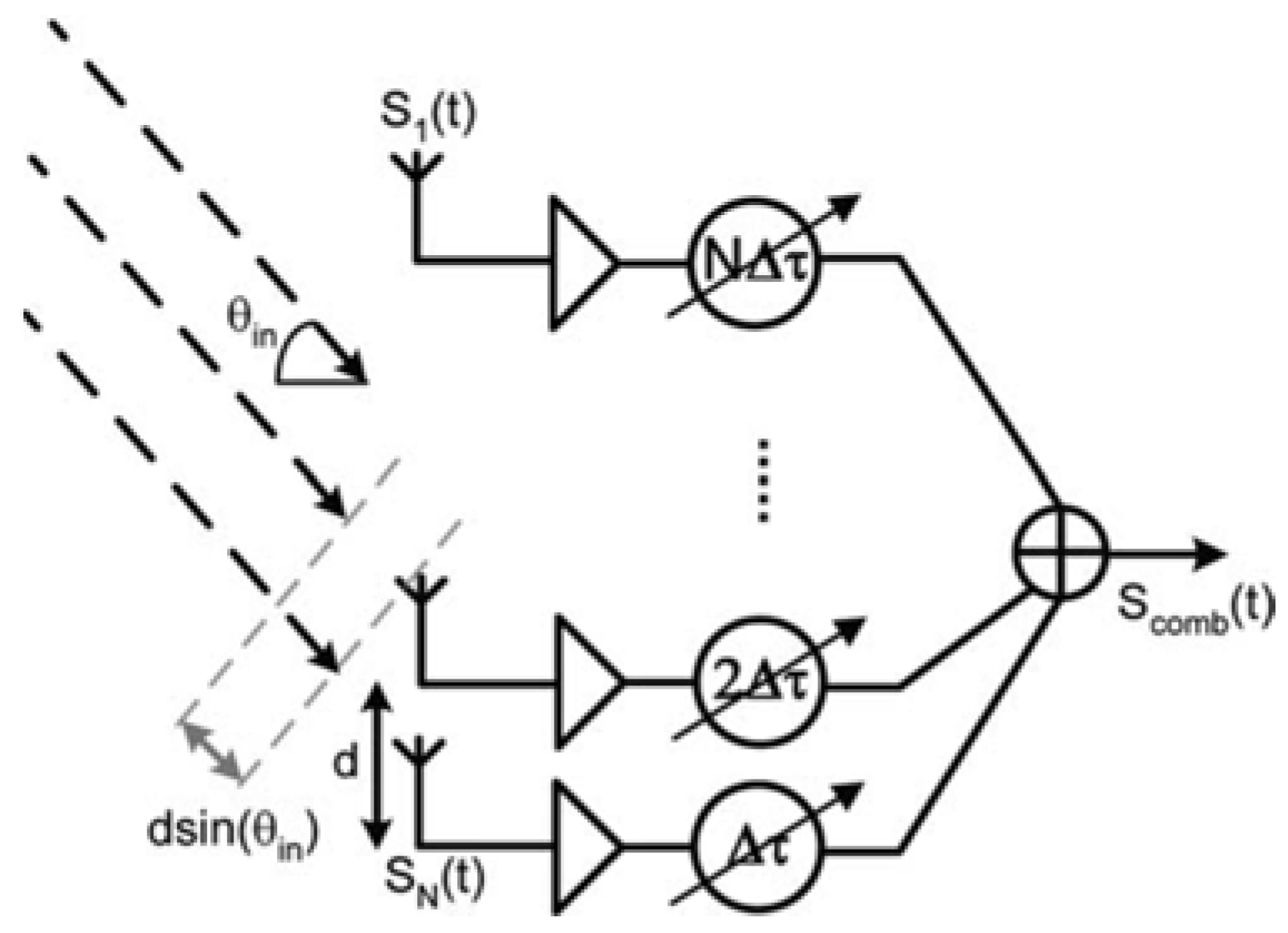
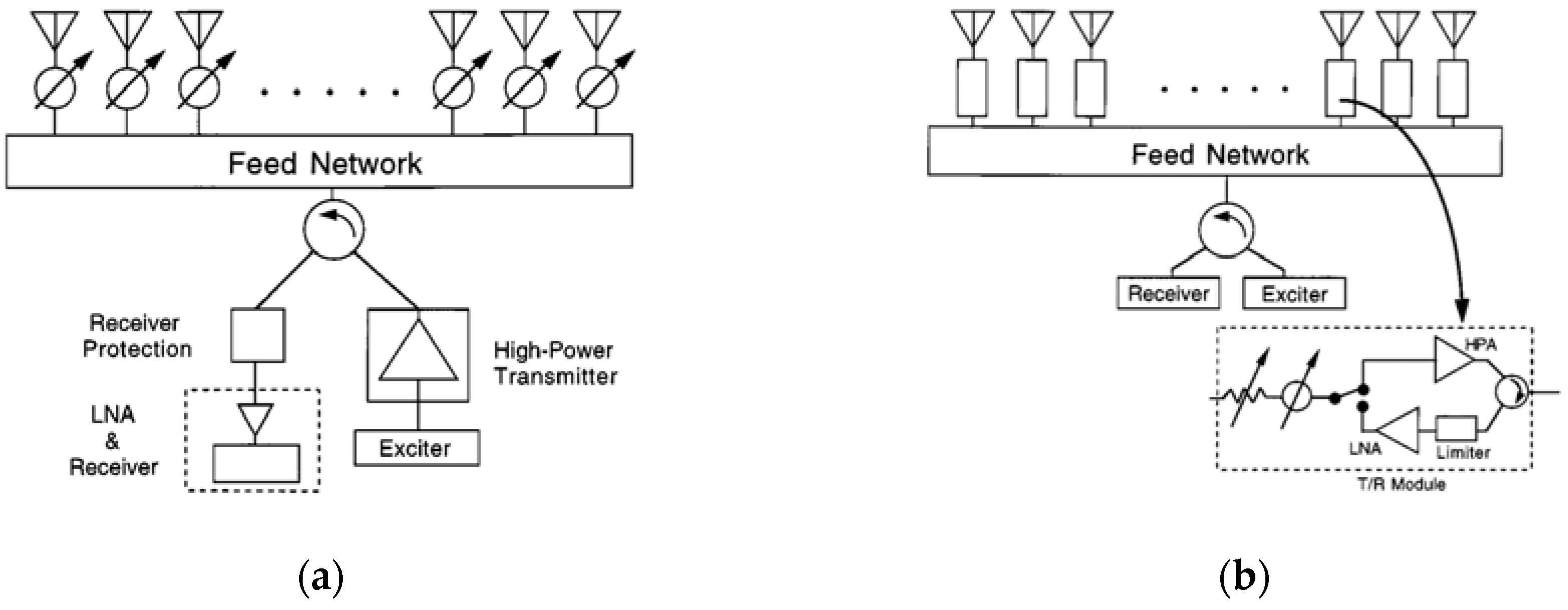
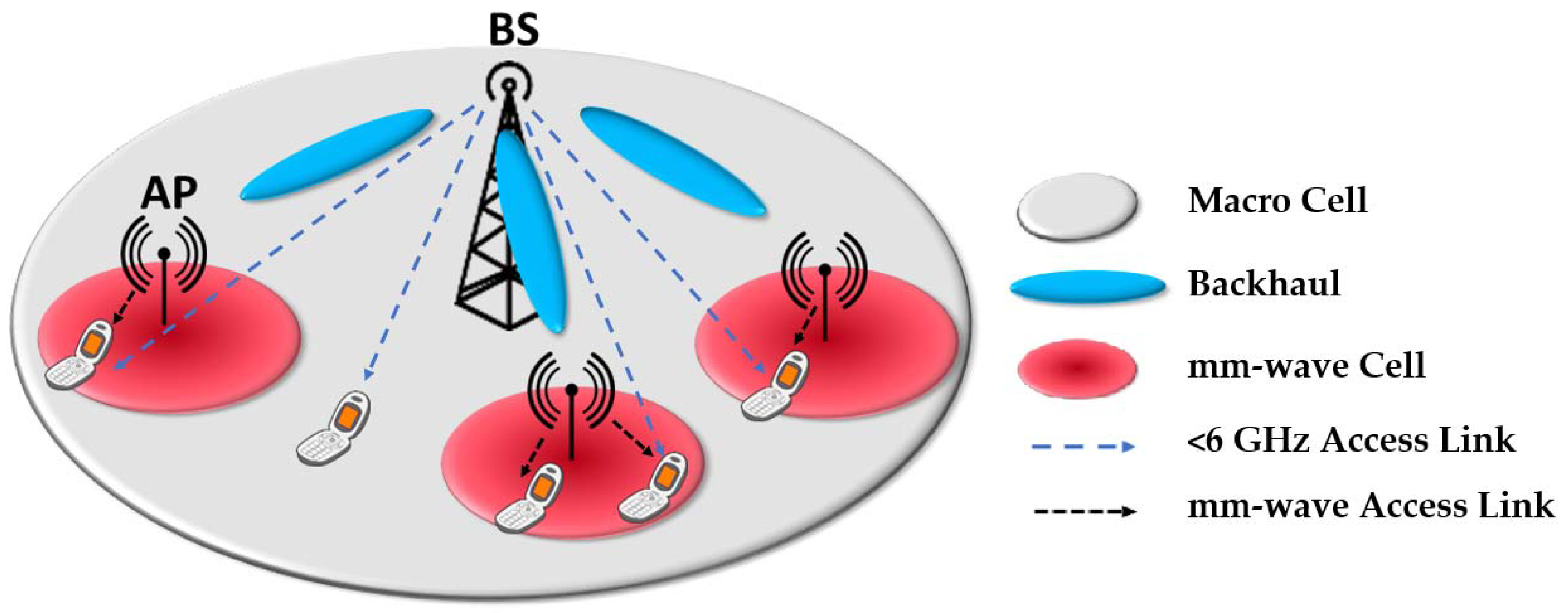




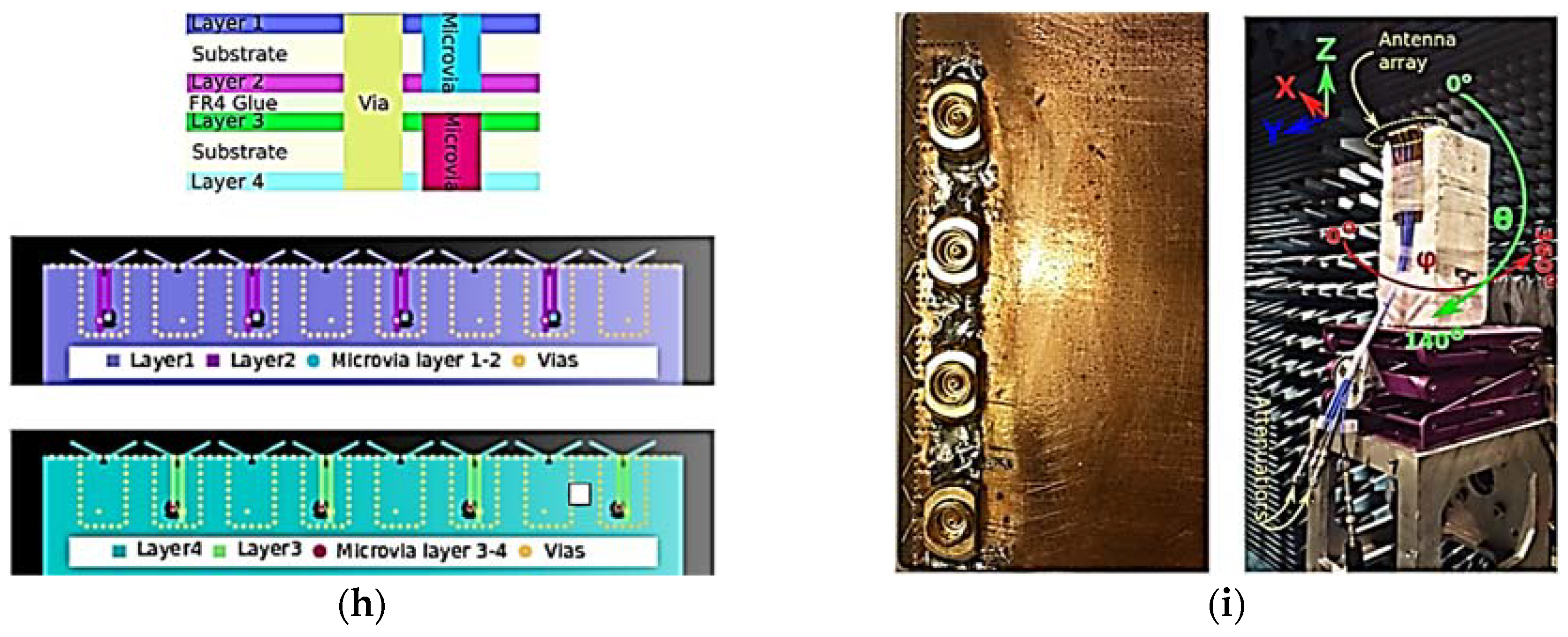


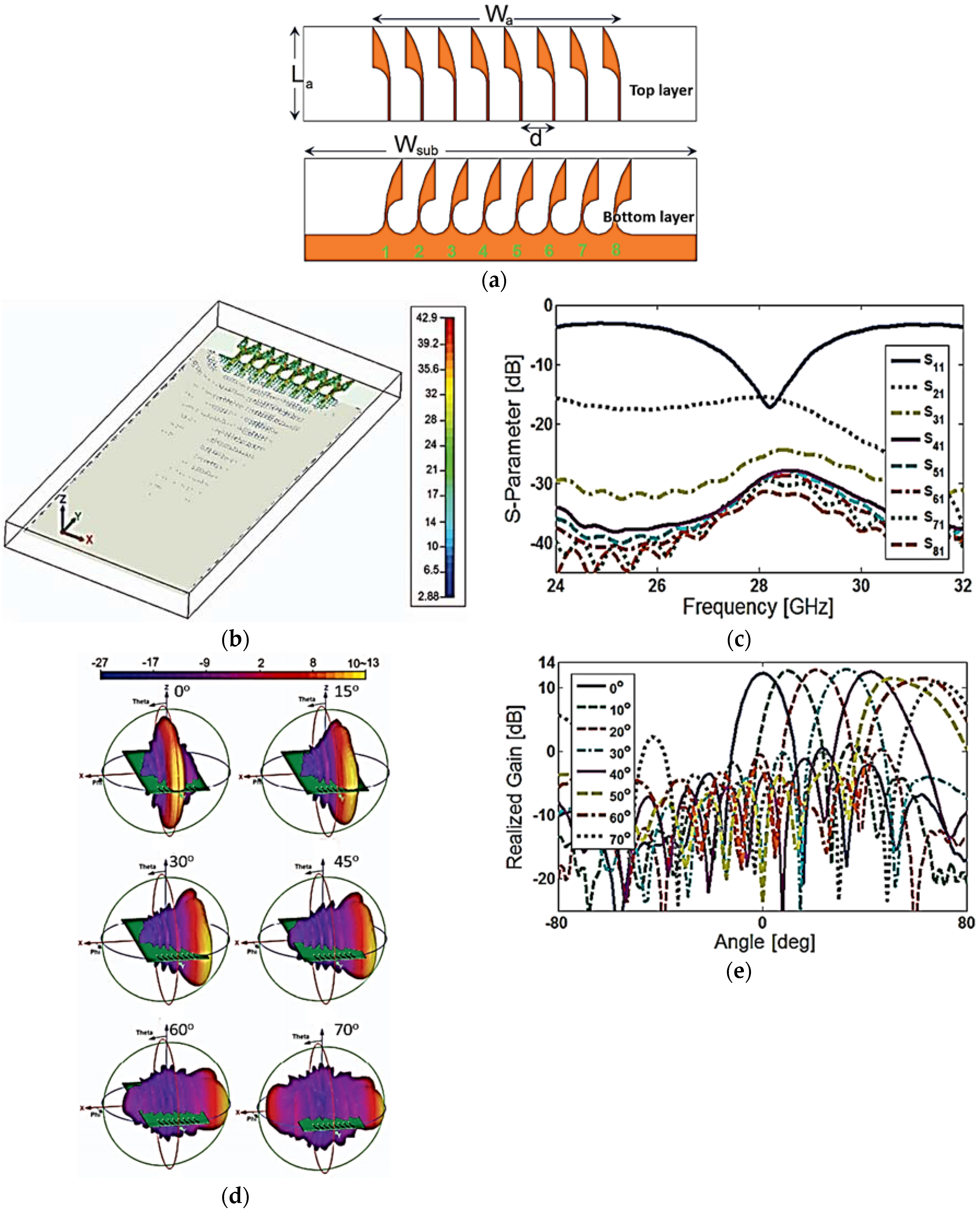

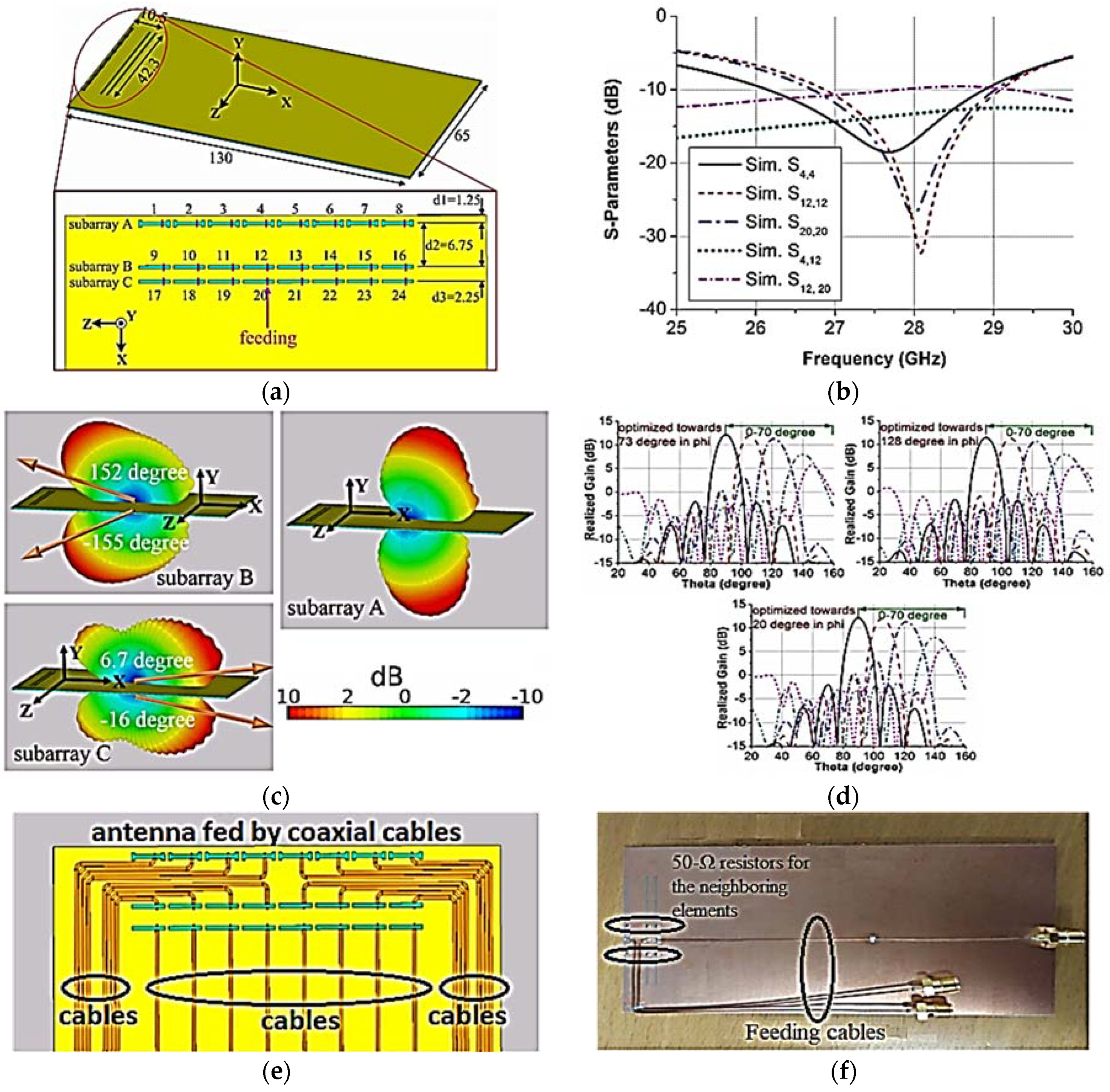


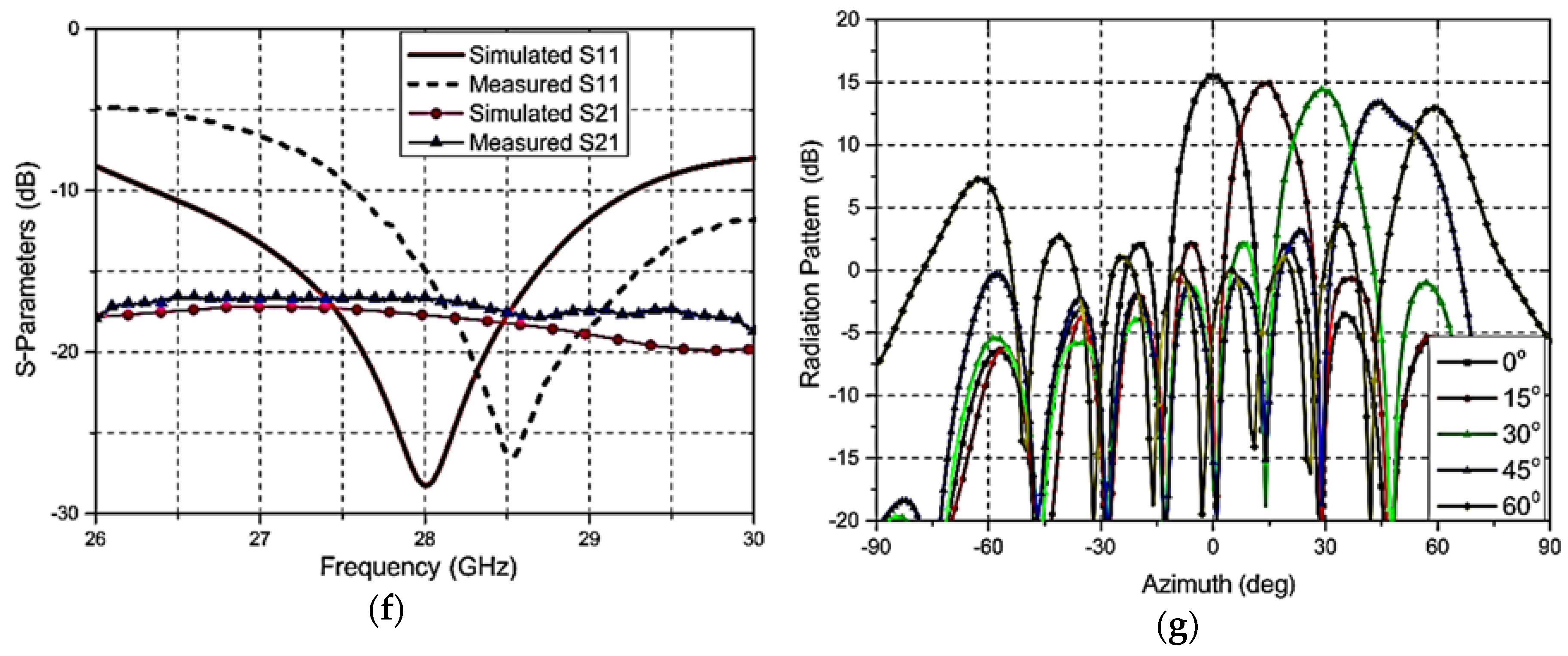
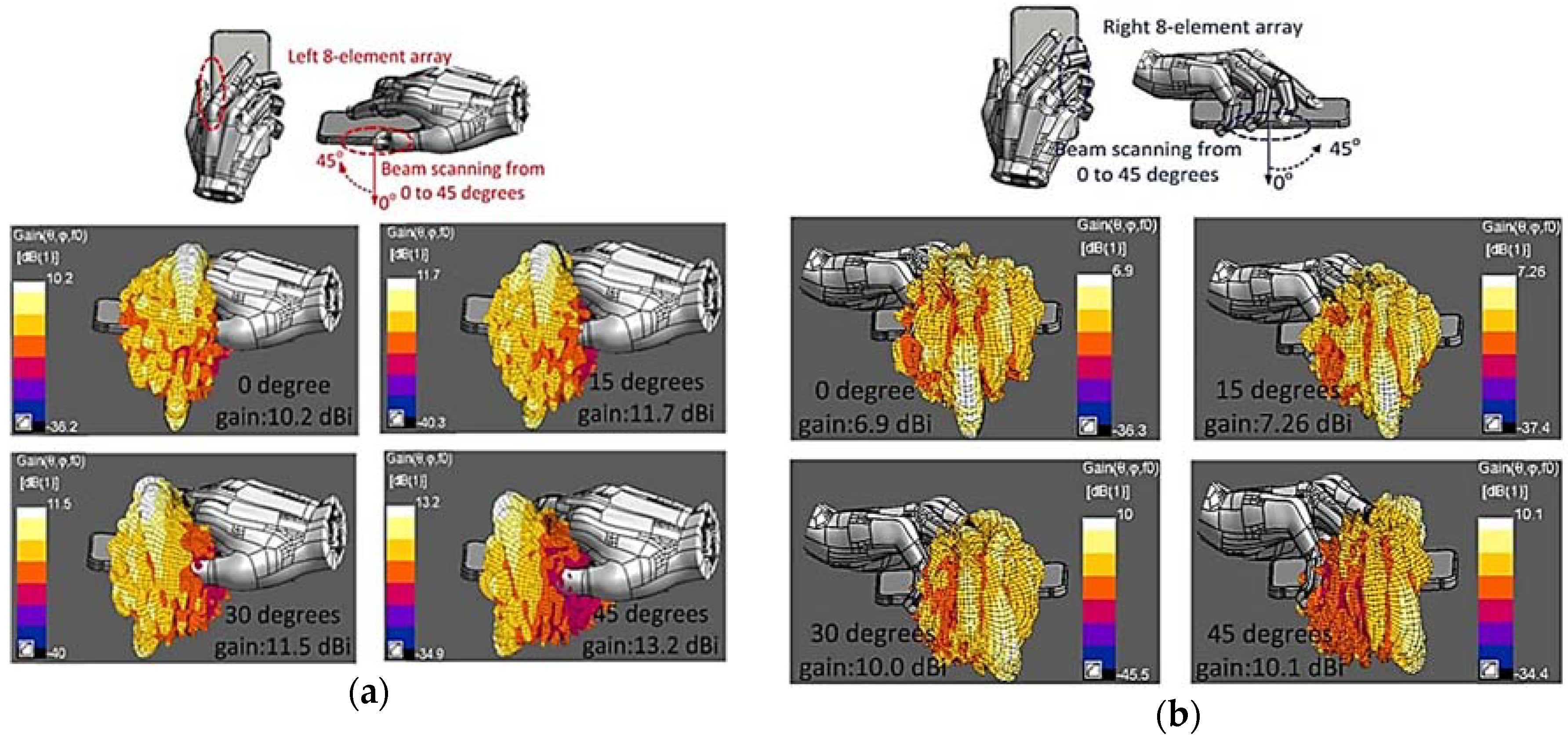


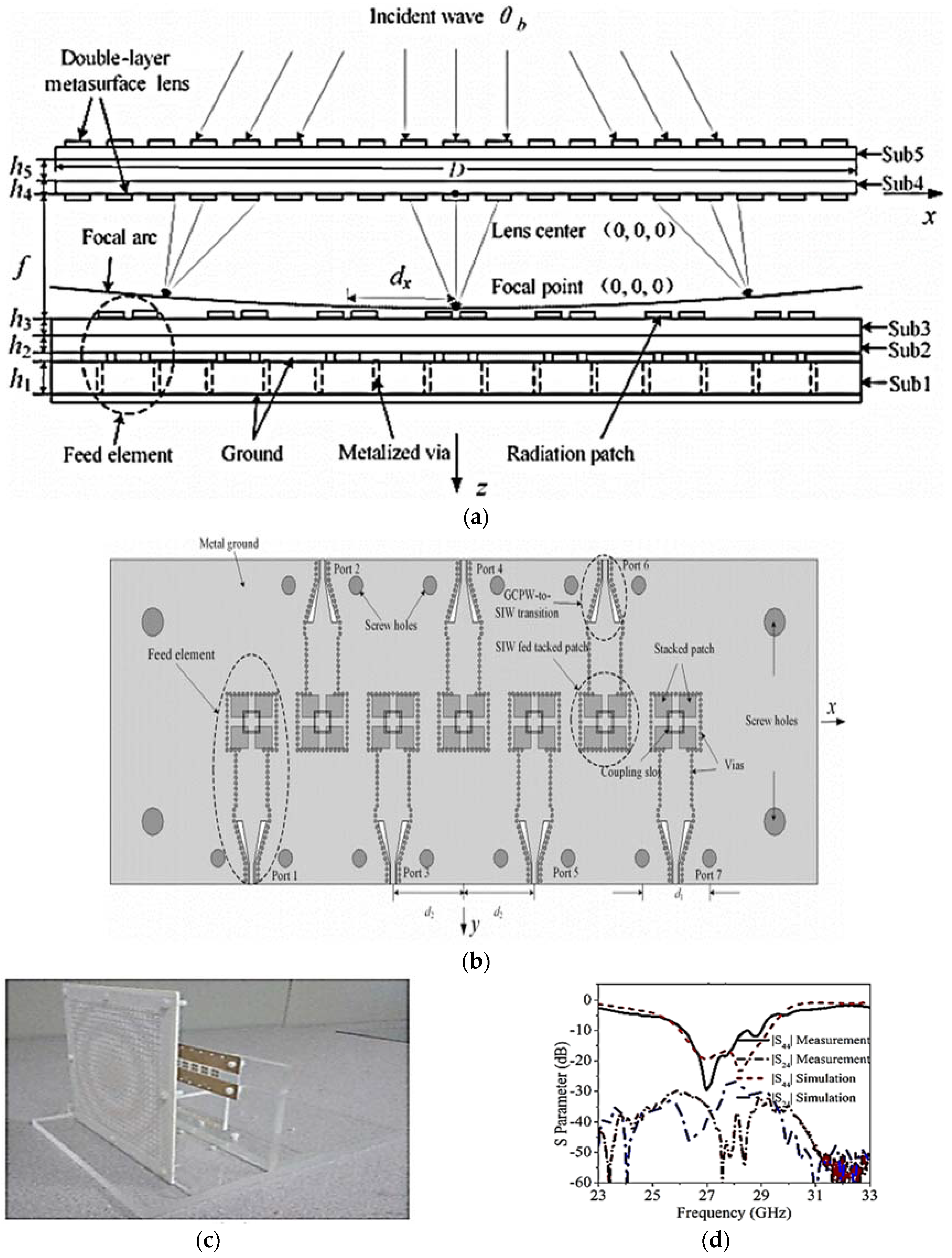

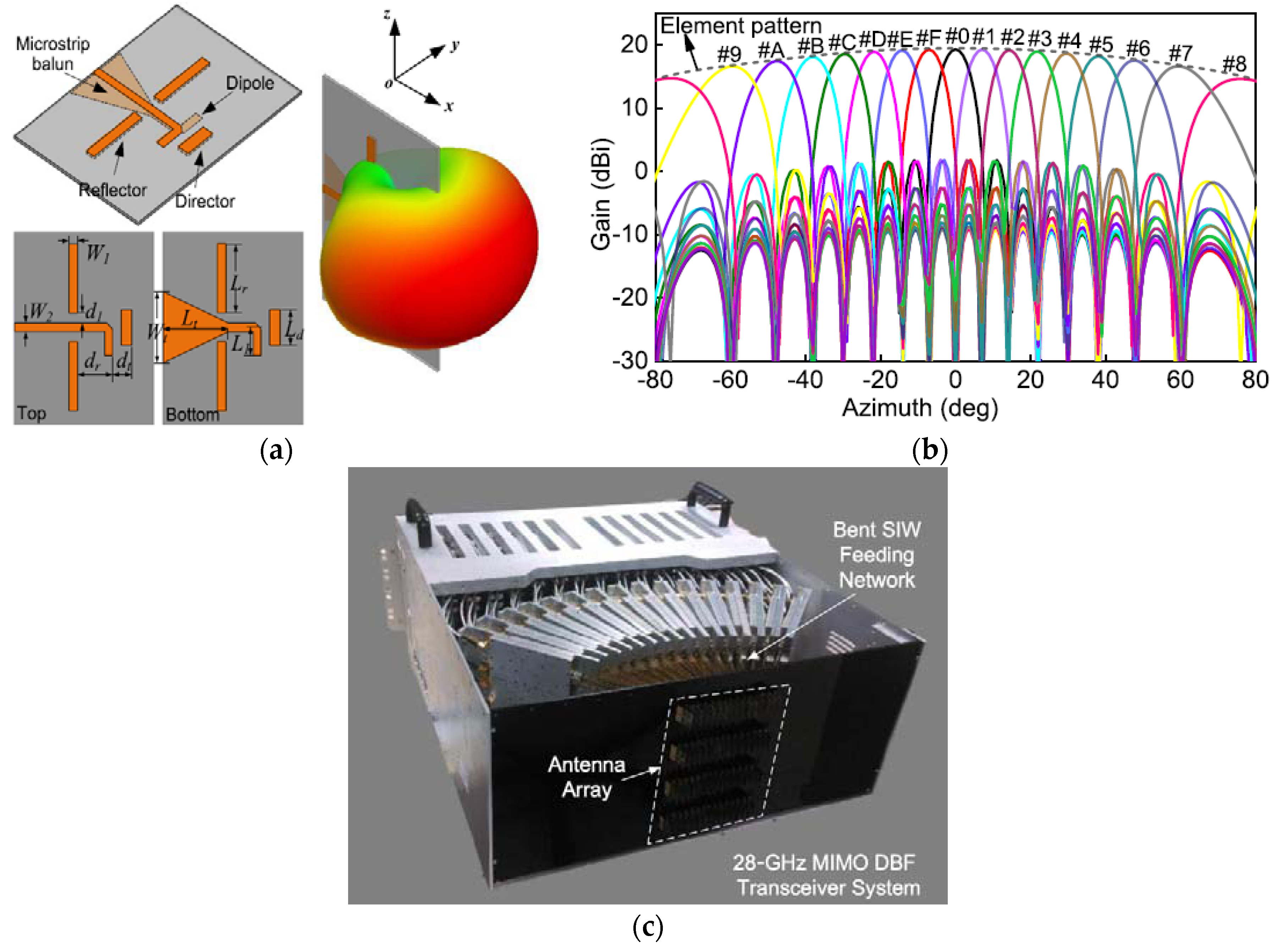
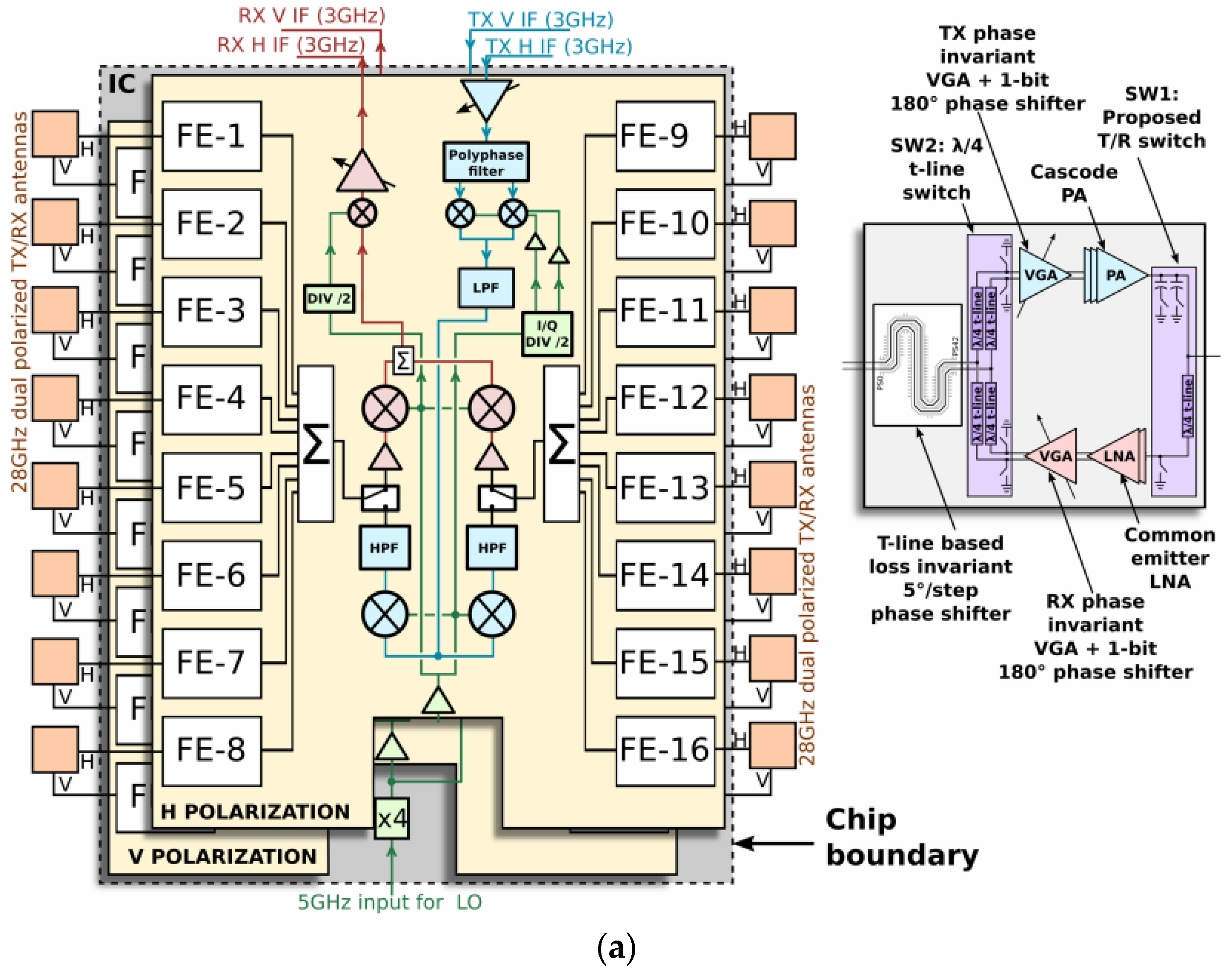
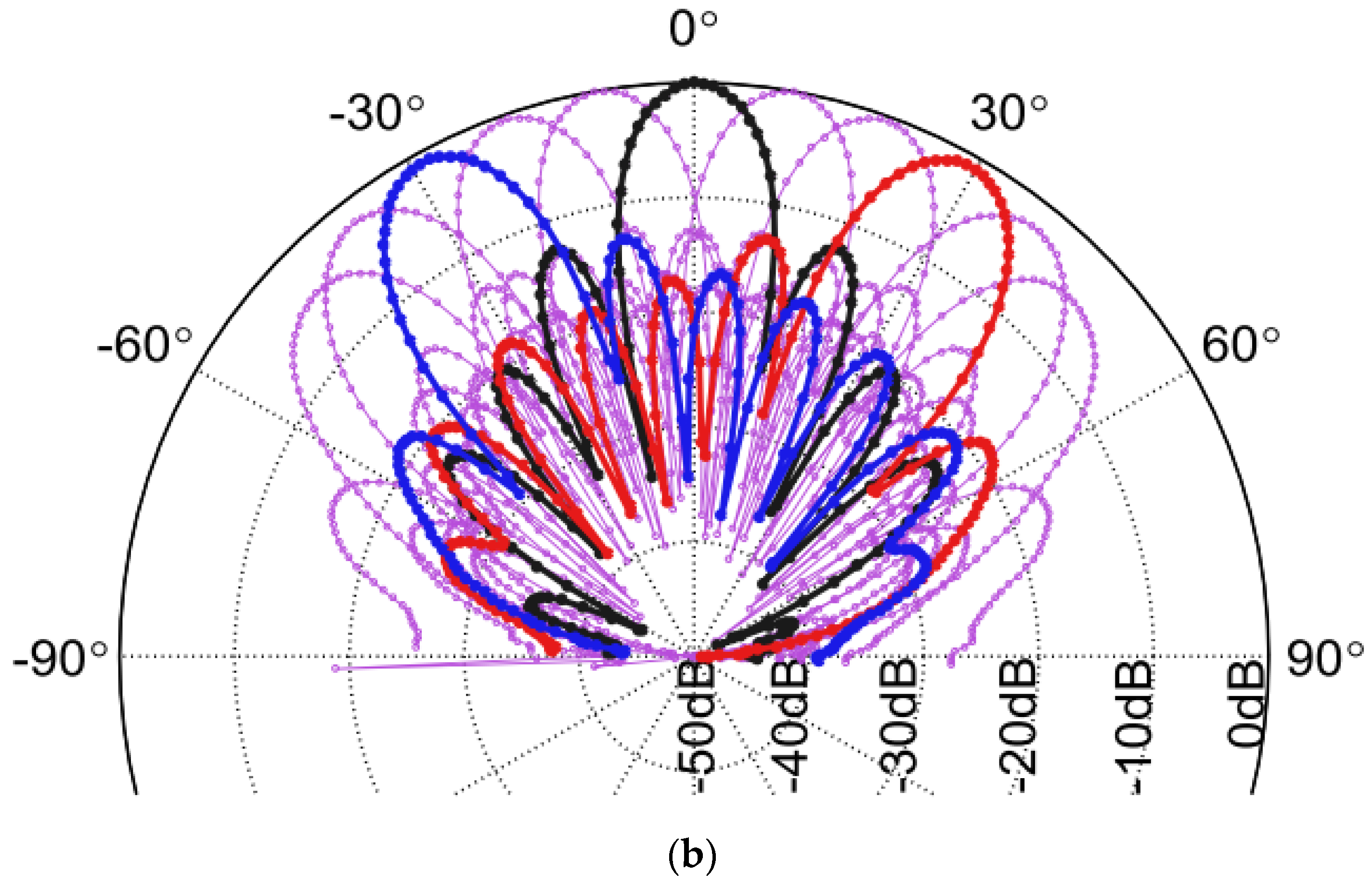
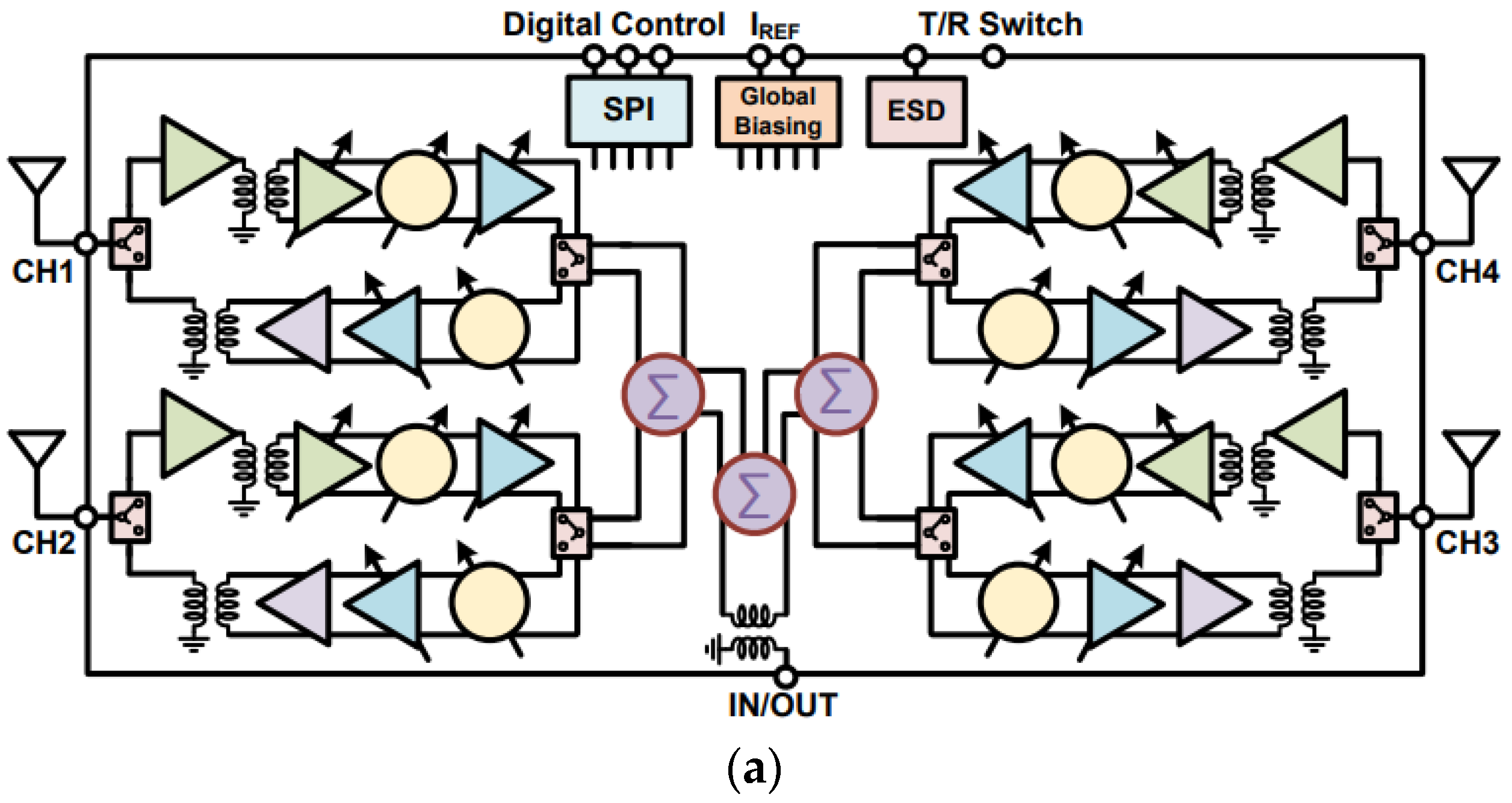
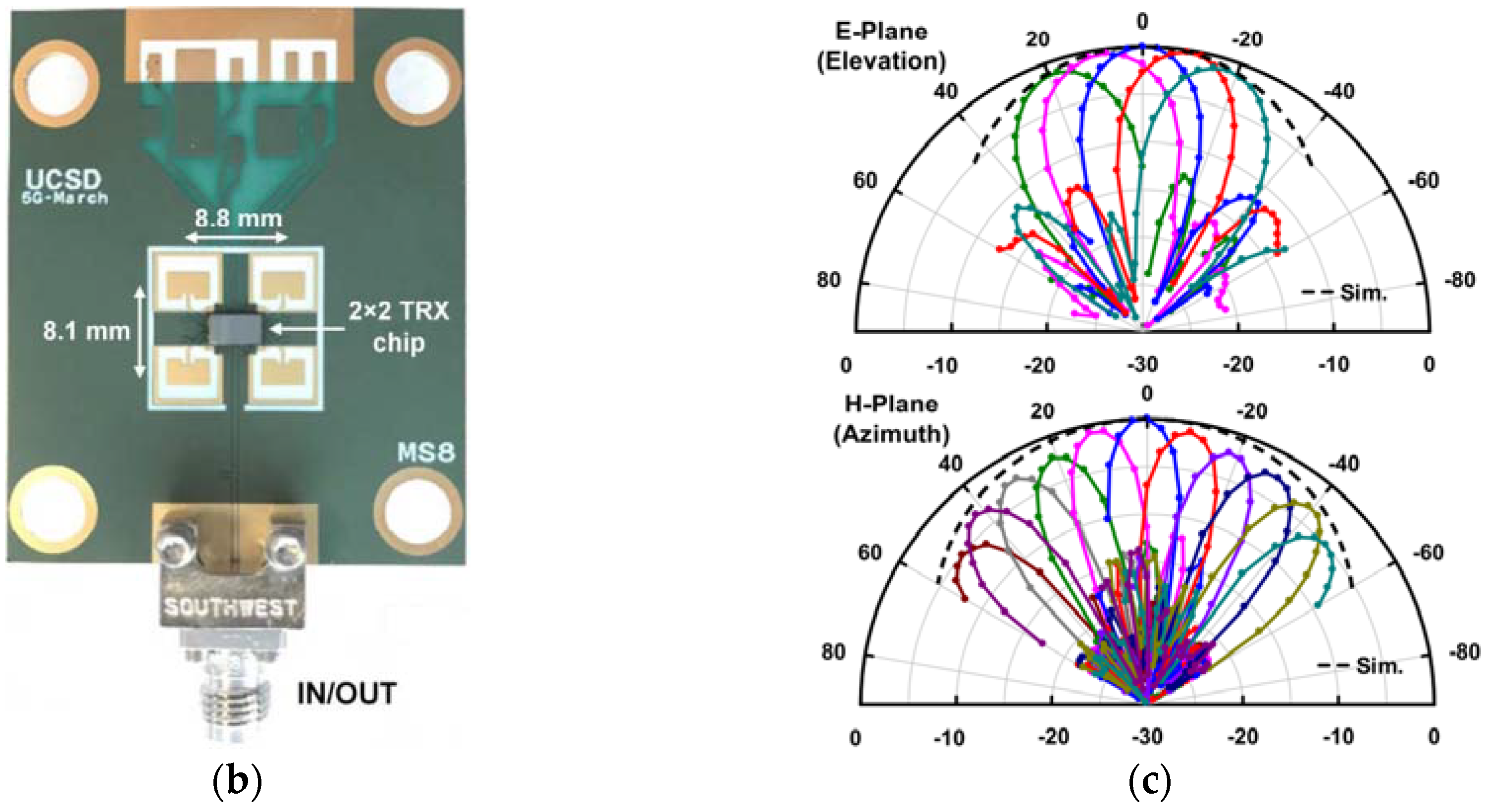
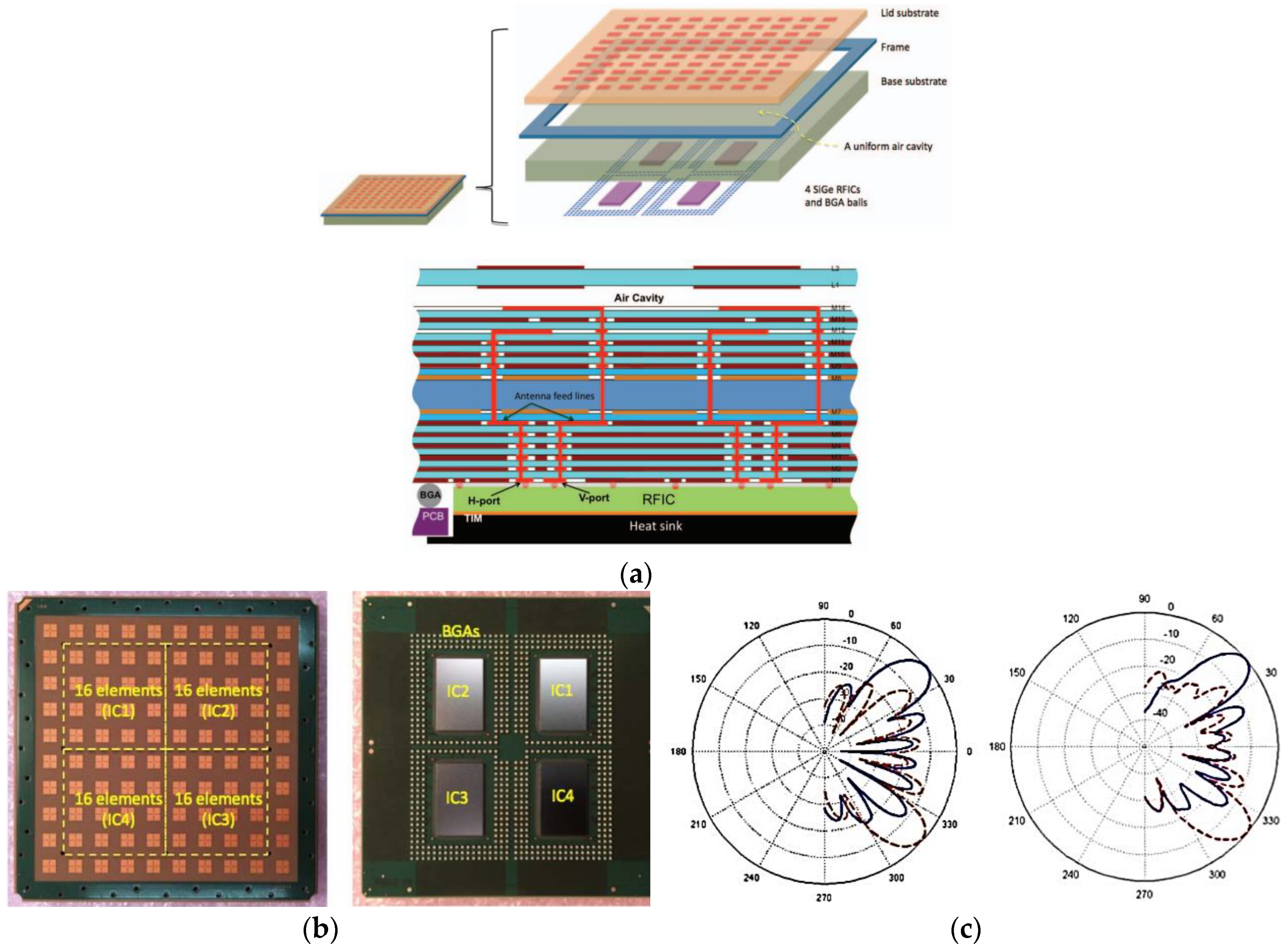
| Ref # | No. of Subarrays | Elements Per Subarray | fo (GHz) | BW (GHz) | Beam-Scanning (deg) | Peak Gain (dBi) | Substrate | Array Position |
|---|---|---|---|---|---|---|---|---|
| [10] | 2 | 1 × 16 | 27.9 | =1 | ±70° | 10.5 | Multilayer-PCB | Top and Bottom |
| [46] | 4 | 1 × 16 | 28 | - | ±80° | - | Multilayer-FR4 | Four Corners |
| [49] | 3 | 1 × 8 | 21.5 | =1 | ±90° | 12.5 | Nelco N9000 | Top |
| [48] | 1 | 1 × 8 | 28 | >1 | ±70° | 12 | N900 PTFE | Top |
| [50] | 3 | 1 × 8 | 28 | =2 | ±73°, ±128°, ±20° | 12.5 | Nelco N9000 | Top |
| [41] | 2 | 1 × 8 | 28 | >2.5 | ±60° | 15.6 | Metallic casing | Left and Right |
| [42] | 1 | 1 × 8 | 28 | >8 | ±90° | 12 | Taconic RF-30 | Top |
| [47] | 3 | 1, 1 × 4, 1 | 36 | >2 | - | 11 | Multilayer-PCB | Top (Mid + Corners) |
| Ref # | Array/IC Elements | Elements in Package | TX/RX Polarizations Per IC | fo (GHz) | Beam-Scanning (deg) | Gain (Tx/Rx) (dBi) | Technology | TX/RX Interface | Package Specification / Integration Level |
|---|---|---|---|---|---|---|---|---|---|
| [9] | 32 × 32 | 1024 | - | 28 | - | - | Single-layer PCB | - | (HUST) Array Antenna architecture |
| [13] | 6 × 8 | 48 | - | 28 | ±110° | 21 | Single-layer PCB | - | (Samsung) MIMO Antenna transceiver |
| [39] | 1 × 7 | 7 | - | 28 | ±27° | 24.2 | Multilayer PCB | - | Antenna only |
| [15] | 16 × 4 | 64 | - | 28 | ±67° | 29/27 | Single-layer PCB | - | (Bell Labs) MIMO transceiver with DBF architecture |
| [55] | 4 × 8 | 32 | - | 27.925 | ±30° | 18 | Single-layer PCB | - | (Samsung) Array Antenna architecture |
| [53,65] | 16 × 2 | 128 | 2/2 | 28 | ±50° | 32/34 | 0.13 µm SiGe BiCMOS | 3 GHz IF | (IBM) Antenna in package |
| [54,60] | 2 × 2 | 4 | 1/1 | 29 | ±50°, ±25° | 18/12 | 0.18 µm SiGe BiCMOS | RF | (UCSD) Antenna on PCB |
| [61] | 2 × 4 | 8 | 1/1 | 28 | ±20° | 14 | 28 nm CMOS | Analog IQ BB | (LG) Antenna in package |
| [63] | 4 × 6 | 24 | 2/2 | 28 | ±45° | 44/34 | 28 nm CMOS | 6.5 GHz IF | (Qualcomm) Antenna in package |
| [66] | 2 × 2 | 4 | - | 28 | ±45° | - | Multilayer PCB and Flip-chip module | - | (Qualcomm) Antenna on PCB with packaged ICs |
| [67] | 4 × 4 | 64 | 2/2 | 28 | ±40° | 35 | Multilayer PCB + 4 SiGe BiCMOS | 3 GHz IF interface | (IBM) Antenna in package |
© 2018 by the authors. Licensee MDPI, Basel, Switzerland. This article is an open access article distributed under the terms and conditions of the Creative Commons Attribution (CC BY) license (http://creativecommons.org/licenses/by/4.0/).
Share and Cite
Naqvi, A.H.; Lim, S. Review of Recent Phased Arrays for Millimeter-Wave Wireless Communication. Sensors 2018, 18, 3194. https://doi.org/10.3390/s18103194
Naqvi AH, Lim S. Review of Recent Phased Arrays for Millimeter-Wave Wireless Communication. Sensors. 2018; 18(10):3194. https://doi.org/10.3390/s18103194
Chicago/Turabian StyleNaqvi, Aqeel Hussain, and Sungjoon Lim. 2018. "Review of Recent Phased Arrays for Millimeter-Wave Wireless Communication" Sensors 18, no. 10: 3194. https://doi.org/10.3390/s18103194
APA StyleNaqvi, A. H., & Lim, S. (2018). Review of Recent Phased Arrays for Millimeter-Wave Wireless Communication. Sensors, 18(10), 3194. https://doi.org/10.3390/s18103194






